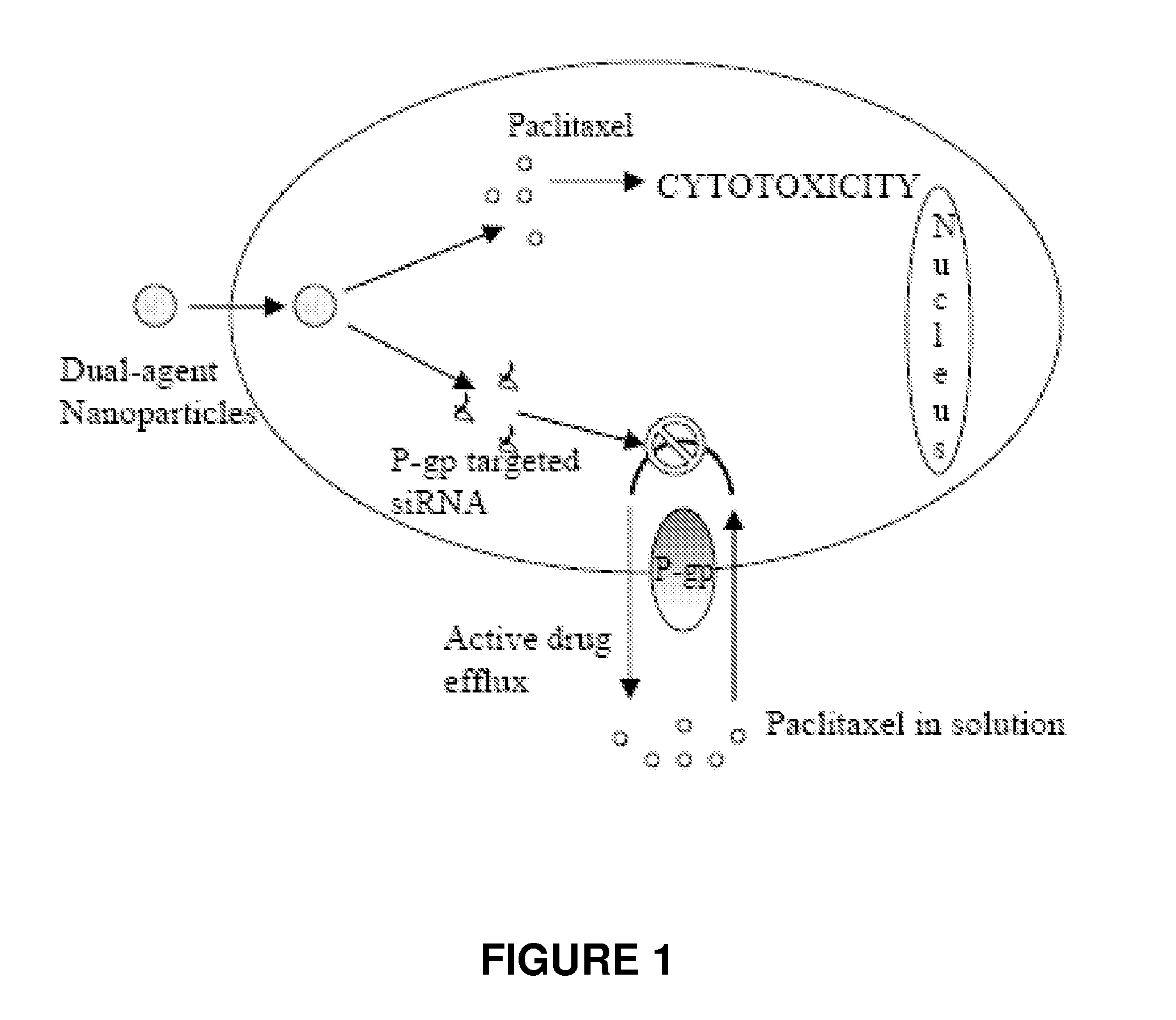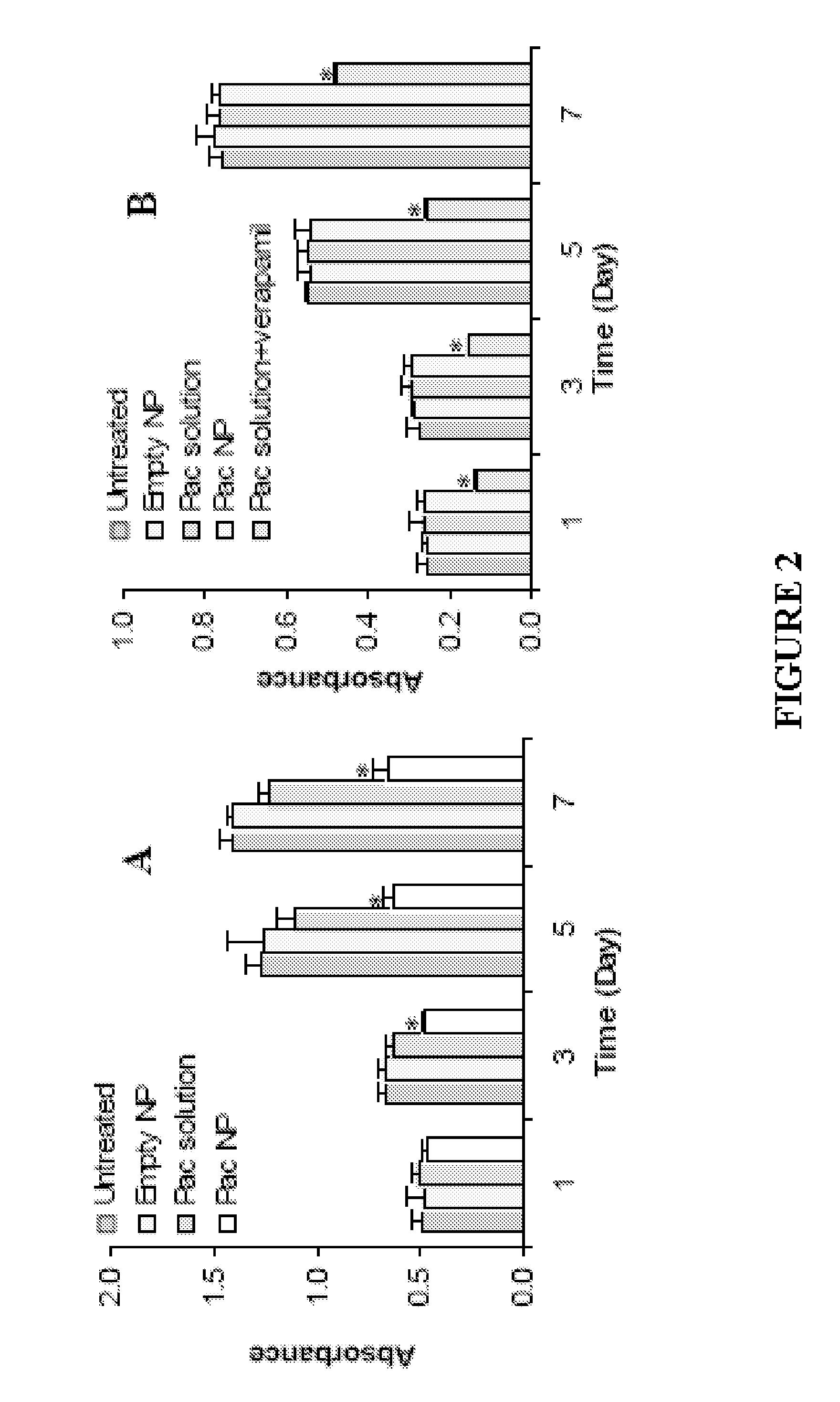Peg and targeting ligands on nanoparticle surface
a technology of nanoparticles and ligands, applied in the field of nanoparticles, peg and targeting moieties, can solve the problems of chemical conjugation, reduced drug availability at the target site, and rapid clearance of the nanoparticulate system used in systemic drug delivery
- Summary
- Abstract
- Description
- Claims
- Application Information
AI Technical Summary
Problems solved by technology
Method used
Image
Examples
example 1
Dual-Agent Nanoparticles that Demonstrate Sustained Cytotoxicity
[0073]For sustained cytotoxicity, it is important that cytotoxic drug levels are maintained for a sustained period of time (Panyam and Labhasetwar, Mol. Pharm. 1:77-84, 2004). The premise for the present Example is that the duration of cytotoxicity of dual-agent nanoparticles depends on the rate of siRNA and paclitaxel release from nanoparticles. This Example entails the determination of cytotoxicity following treatment of drug-resistant tumor cells with nanoparticle formulations that release different doses of siRNA and paclitaxel. The results will be used to identify an optimal nanoparticle formulation that demonstrates sustained cytotoxicity (over 15 days) in resistant tumor cells.
[0074]Duration of 15 days is chosen based on the fact that this is the maximum duration over which cytotoxicity can be studied in vitro in different drug-sensitive and resistant cell lines. This Example yields data regarding the effect of d...
example 2
Kinetics of Tumor-Targeting with Dual-Agent Nanoparticles In Vivo
[0088]The objective of this Example is to determine the kinetics of tumor targeting in a mouse tumor xenograft model with nanoparticles that are optimized for sustained cytotoxicity in vitro. This Example is designed to test the hypothesis that the presence of PEG and folic acid on the surface of nanoparticles will enhance tumor-targeting of nanoparticles. The approach used to test this hypothesis will be determination of kinetics of nanoparticle accumulation in tumor tissue following treatment with nanoparticle formulations with different amounts of PEG and folic acid in a mouse xenograft tumor model. Data will be obtained regarding the kinetics of drug and siRNA accumulation in tumor, including the rate and extent of nanoparticle accumulation in tumor tissue. This will enable determination of the dose of nanoparticles required for sustained tumor regression with dual-agent nanoparticles. This will result in improved ...
example 3
In Vivo Anti-Tumor Efficacy of Dual-Agent Nanoparticles
[0097]A number of delivery vectors that demonstrate good efficacy in vitro do not perform as well in vivo due to instability in the presence of serum, toxicity and / or immunogenicity problems (Cohen et al., Gene Ther. 7:1896-905, 2000). Hence, it is important to demonstrate anti-tumor efficacy of dual-agent nanoparticles in vivo. One objective of this Example is to establish the anti-tumor efficacy of dual-agent nanoparticles in a mouse xenograft model of drug resistant tumor. The Example is designed to test the hypothesis that dual-agent nanoparticles that demonstrate sustained cytotoxicity in vitro and enhanced tumor-targeting in vivo will result in regression of resistant tumor in vivo. The approach used is evaluation of dose dependency in tumor growth suppression following intravenous injection of dual-agent nanoparticles in mouse xenograft model of tumors overexpressing either P-gp or Hsp70. An optimized nanoparticle formula...
PUM
| Property | Measurement | Unit |
|---|---|---|
| time | aaaaa | aaaaa |
| time | aaaaa | aaaaa |
| time | aaaaa | aaaaa |
Abstract
Description
Claims
Application Information
 Login to View More
Login to View More - R&D
- Intellectual Property
- Life Sciences
- Materials
- Tech Scout
- Unparalleled Data Quality
- Higher Quality Content
- 60% Fewer Hallucinations
Browse by: Latest US Patents, China's latest patents, Technical Efficacy Thesaurus, Application Domain, Technology Topic, Popular Technical Reports.
© 2025 PatSnap. All rights reserved.Legal|Privacy policy|Modern Slavery Act Transparency Statement|Sitemap|About US| Contact US: help@patsnap.com



